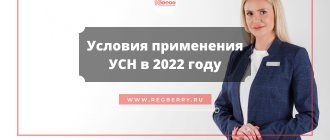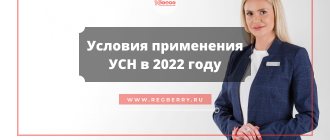Deflator coefficient for 2022 for UTII
When calculating the “imputed” tax, two types of coefficients are used; deflator coefficient K1 and reduction coefficient K2. The K1 deflator adjusts the basic profitability indicator established for certain types of business that fall under UTII (Article 346.29 of the Tax Code of the Russian Federation).
The value of the K1 coefficient, effective in 2022 (1.798), has not changed for 3 years. Using the new deflator coefficient for 2022, UTII payers will have to transfer 3.4% more to the budget, since the value of K1 will increase to 1.868. This situation may arise even if the “imputed” person’s physical indicators remain at the same level in 2022 and the local K2 coefficient does not change. Read more about the coefficients for UTII here.
Expert forecasts
Forecasts of changes in deflator indices offered by the Ministry of Economic Development were discussed in the table below. Let's dwell on the opinions of other experts.
Central Bank
The Central Bank sees the prospect of an increase in oil prices to $55 per barrel and a decrease in the influence of the commodity market on the position of the ruble. Basically, the Central Bank agrees with the indicators given by the Ministry of Economic Development, adjusted for inflation of 4%. Russians' inflation expectations remain at 7.8%. In addition, an increase in VAT will lead to an increase in the cost of goods.
Deflator coefficient USN
In the “simplified” system, the deflator coefficient is used to adjust the income limits at which the taxpayer has the right to switch to the simplified tax system from other regimes, and also remain a “simplified” if he is already working on this tax system.
Despite the fact that by Order No. 579 the value of the coefficient for the “simplified tax” for the next year was established and even became higher, there is no need to apply the deflator coefficient for 2022 when switching to or working on the simplified tax system. This is due to the provisions of the law dated 07/03/2016 No. 243-FZ, according to which, starting from 01/01/2017 and until 01/01/2020, the operation of “simplified” coefficients is suspended. In addition, the same law established the deflator coefficient for 2022 equal to 1, so we can say that the deflator coefficient for 2018-2020. for "simplified" is actually absent.
Let us remind you that in 2017-2018, the income limit for 9 months, which gives organizations the right to switch to the simplified tax system, is 112.5 million rubles, and the income limit that allows you to remain on the simplified regime is 150 million rubles. (clause 4 of article 346.13 of the Tax Code of the Russian Federation). These amounts are not subject to indexation in the coming year. Read about how to switch to the simplified tax system in 2018 here.
What are the predicted values
The official order of the Ministry of Economic Development on the deflator index for 2021 has not yet been published, but forecast values in various production areas have already been presented. These values will still be adjusted taking into account recent economic changes.
When developing the budget and planning procurement activities for the next year and planning periods, use the existing coefficient values calculated by the ministry’s specialists.
Let's present the deflator indices of the Ministry of Economic Development until 2024 in the table.
| Industries | 2021 | 2022 | 2023 | 2024 |
| Mining | 103,1 | 103,8 | 104,1 | 104,2 |
| Mining of oil and gas | 102,7 | 103,5 | 103,7 | 103,9 |
| Manufacturing industries | 103,3 | 104,1 | 104,2 | 104,3 |
| Industry | 103,4 | 104,0 | 104,1 | 104,2 |
| Providing electricity, gas and steam | 104,0 | 104,0 | 104,0 | 104,0 |
| Water supply and sanitation | 104,0 | 104,0 | 104,0 | 104,0 |
| Construction | 104,1 | 105,1 | 104,3 | 104,4 |
| Agriculture | 103,1 | 103,9 | 103,9 | 104,2 |
| Transport | 104,1 | 104,0 | 104,0 | 104,0 |
| Investments in fixed assets (capital investments) | 103,7 | 103,7 | 103,8 | 103,8 |
| Retail trade turnover | 103,5 | 104,3 | 103,9 | 104,0 |
| Paid services to the population | 104,2 | 103,9 | 104,2 | 104,1 |
The index for consumer goods is planned at 104.2. Retail electricity prices will be indexed to 104.0.
On September 30, 2022, the Ministry of Economic Development published a forecast of social development until 2024. Experts determined the level of economic growth and inflation:
According to calculations, the consumer price index of the Ministry of Economic Development for 2021 will be:
Deflator coefficient for patent for 2022
The potential annual income of an entrepreneur when working on a patent is 1 million rubles. (clause 7 of article 346.43 of the Tax Code of the Russian Federation). This amount is adjusted by the deflator coefficient, which was increased from 1.425 to 1.481 by the order establishing deflator coefficients for 2022.
This means that the potential income of an individual entrepreneur for calculating the cost of a patent in 2018 could be 1.481 million rubles. (1 million x 1.481). The resulting value is multiplied by the “patent” tax rate and divided by the number of months in the year:
RUB 1.481 million x 6%: 12 months. = 7405 rub. - this is the maximum cost of a patent per month in 2022, which has increased by 280 rubles compared to 2017 (RUB 7,125).
Let us recall that in the regions the potential annual income of an entrepreneur on a patent can be increased to three, five or ten times the amount (clause 8 of Article 346.43 of the Tax Code of the Russian Federation), depending on the number of residents and a number of other factors. This means the cost of the patent itself. Read more about PSN here.
Application of indices and deflators to calculate prices of military products
The procedure for using price indices and deflator indices by type of economic activity, as well as other indicators as part of the forecast of socio-economic development of the Russian Federation when setting prices for products supplied under the state defense order, was approved by Order of the Ministry of Economic Development of Russia dated April 1, 2020 No. 190. When determining the prices of products supplied within the framework of the state defense order, the base price indexation method or the indexation method by cost items, the indices of the base version
of the medium-term Forecast are used by type of economic activity, which includes the production of each specific type of product, material, raw material, purchased component, semi-finished product. If it is impossible to detail the costs of producing defense products, the PPI “Industry (BCDE)” is used. Indexation of prices for military equipment and weapons, including weapons and ammunition, is carried out according to the producer price index for engineering products (26, 27, 28, 29, 30, 33). When calculating the price of imported consumer goods, we use the index of changes in the nominal exchange rate of the ruble. The cost of work and services of third-party organizations is calculated, as a rule, using an index equal to half the sum of the consumer price indices (CPI) and prices. The maximum amount of funds for capital investments (construction work, reconstruction, technical re-equipment of capital construction projects) is determined by the deflator index “Investments in fixed capital from all sources of financing.”
Long-term forecast
The long-term period
is the period following the current year, lasting more than six years. The indicators of the long-term (twelve-year) forecast of the Ministry of Economic Development for the period until 2036 (from 2025), used for the purpose of pricing defense products, were communicated by letter dated December 7, 2018 No. 36097-AT/D03i. This forecast provides for a stable annual increase in consumer prices of exactly 4.0%, and a gradual decrease in the PPI “Engineering products (26, 27, 28, 29, 30, 33)” from 4.9% (2026) to 4.4 % (in 2036). The rules for the development, adjustment, monitoring and control of the implementation of the forecast for the socio-economic development of the Russian Federation for the long term are approved by Decree of the Government of the Russian Federation of November 11, 2015 No. 1218.
Deflator coefficient - trading fee
The deflator coefficient also applies to the trading fee, or more precisely to the fee rate established for the activities of organizing retail markets. Its basic meaning, according to clause 4 of Art. 415 of the Tax Code of the Russian Federation, is 550 rubles. per 1 sq. m of market area.
In 2022, it was necessary to multiply the base tax rate by 1.237 (680 rubles per 1 sq. m), and the deflator coefficient for 2022, the Ministry of Economic Development decided to raise to 1.285 (707 rubles per 1 sq. m), which will increase the amount of the trade fee in the new year by 3.88%.
Strategic planning
Strategic planning in the Russian Federation is carried out at the federal level, as well as at the levels of constituent entities and municipalities. Legal foundations of strategic planning (goal setting, forecasting and programming of the country's development); as well as the powers, coordination and procedure for interaction of planning participants at all levels are established by the Federal Law of June 28, 2014 No. 172-FZ “On Strategic Planning in the Russian Federation”. Strategic planning documents developed at the federal level include a forecast of the socio-economic development of the Russian Federation for the medium term, created within the framework of goal setting on a sectoral and territorial basis. This medium-term Forecast is approved by the Government of Russia and is taken into account when adjusting the forecast for the socio-economic development of the Russian Federation for the long term.
Deflator coefficient: personal property tax
Article 404 of the Tax Code of the Russian Federation instructs individual taxpayers to calculate property tax taking into account the deflator coefficient. This is a necessary condition for calculating tax from inventory value. The tax authorities receive information about the value of the property from the authorities registering rights to real estate.
By the order establishing deflator coefficients for 2022, the coefficient value for property tax of individuals was set at 1.481. In 2022, the inventory value of the property was multiplied by 1.425.
Please note that the new value of the deflator coefficient will be applied in 2022, but for calculating personal property taxes for 2022.
Deflator coefficient for personal income tax
The income tax deflator is used only in calculating the fixed payment of foreign citizens working in the Russian Federation under a patent (in other words, it affects the cost of a patent for a foreigner). During the validity period of the patent, foreigners pay a monthly advance payment in the amount of 1200 rubles, adjusted by the deflator coefficient (clause 3 of Article 227.1 of the Tax Code of the Russian Federation). In 2022, it will be 1.686, instead of the current value of 1.623, which means that the amount of the monthly advance payment will increase to 2023 rubles. (1200 rub. x 1.686), instead of 1948 rub. in 2022. Let us recall that here, too, regions have the right to set their own values for the cost of a patent for a foreigner. In 2022, Moscow and the Moscow region have decided that in these regions the cost of a patent will increase.
Indices by type of economic activity
For each area of economic activity, forecast index indicators for 2022–2022 have been developed and approved.
Industrial production indices (selected) for 2022:
| Name | Option | 2019 |
| Industry | Base | 101,9 |
| Conservative | 101,6 | |
| Target | 102,6 | |
| Minerals (mining) | Base | 101,0 |
| Conservative | 100,9 | |
| Target | 101,4 | |
| Manufacturing industries | Base | 102,7 |
| Conservative | 102,1 | |
| Target | 103,6 | |
| Petroleum products production | Base | 102,5 |
| Conservative | 101,4 | |
| Target | 102,7 | |
| Metallurgical production | Base | 101,7 |
| Conservative | 101,4 | |
| Target | 102,8 | |
| Providing gas and electricity | Base | 101,3 |
| Conservative | 101,2 | |
| Target | 101,8 | |
| Drainage, water supply | Base | 100,1 |
| Conservative | 100,2 | |
| Target | 101,2 |
Deflator coefficient for 2022, 2022, 2022
The calculation of deflator coefficients by specialists of the Ministry of Economic Development of the Russian Federation allows us to plan the development of the country’s economy, implement measures to stabilize it and accelerate the pace of economic development, as well as reduce the risk of negative consequences.
The forecast deflator coefficient for 2022, 2022 and subsequent years allows us to predict the dynamics of changes in prices for goods and services in the current period and in the future. Thus, the Ministry of Economic Development believes that in 2018 we should expect an increase in prices for consumer goods by 4.3%, the cost of coal fuel will increase by 3.5%, gas - by 3.6%, heat supply services - by 4.2% and etc.
An increase in inflation and consumer prices will also cause an increase in deflator coefficients applied to taxes.
As a result, the tax burden on citizens and businesses increases. Although, today there are also positive forecasts that promise stabilization of price growth, strengthening of the ruble and a slowdown in inflation processes. You can find more complete information on the topic in ConsultantPlus. Free trial access to the system for 2 days.
Scenarios
It is simply impossible to find out what prices will be in the future. Therefore, to determine nominal value values (expected), experts take into account the influence of a combination of external and internal factors that directly affect the state of the economy.
The Ministry of Economic Development systematically and periodically evaluates such factors and makes forecasts of various economic indicators for certain scenarios. For 2021, scenarios could be as follows:
- Basic scenario . With it, the current values of the main internal and external factors will be preserved, that is, they will remain unchanged. Thus, sanctions against Russia will continue to apply, the price of oil will vary from 40 to 50 US dollars per barrel, and customs duties will remain at the levels of 2018-2020.
- Favorable scenario . In this case, the development trend will be positive: current sanctions will be lifted, oil prices will rise, and customs duties imposed on Russian goods will decrease.
- Target scenario . This is the most unfavorable and negative scenario in which the impact of a combination of internal and external factors on the economy of the Russian state will be extremely negative. For example, sanctions will be tightened and new ones will be added, oil prices will fall to critical levels, customs duties for national goods will increase significantly, and unemployment and inflation levels will increase in the country.
As can be seen from the table above, the Ministry of Economic Development adhered to a neutral base scenario when forecasting. Indeed, the Russian economy is relatively stable, but events may occur next year that will affect the economic situation negatively or, on the contrary, positively.





